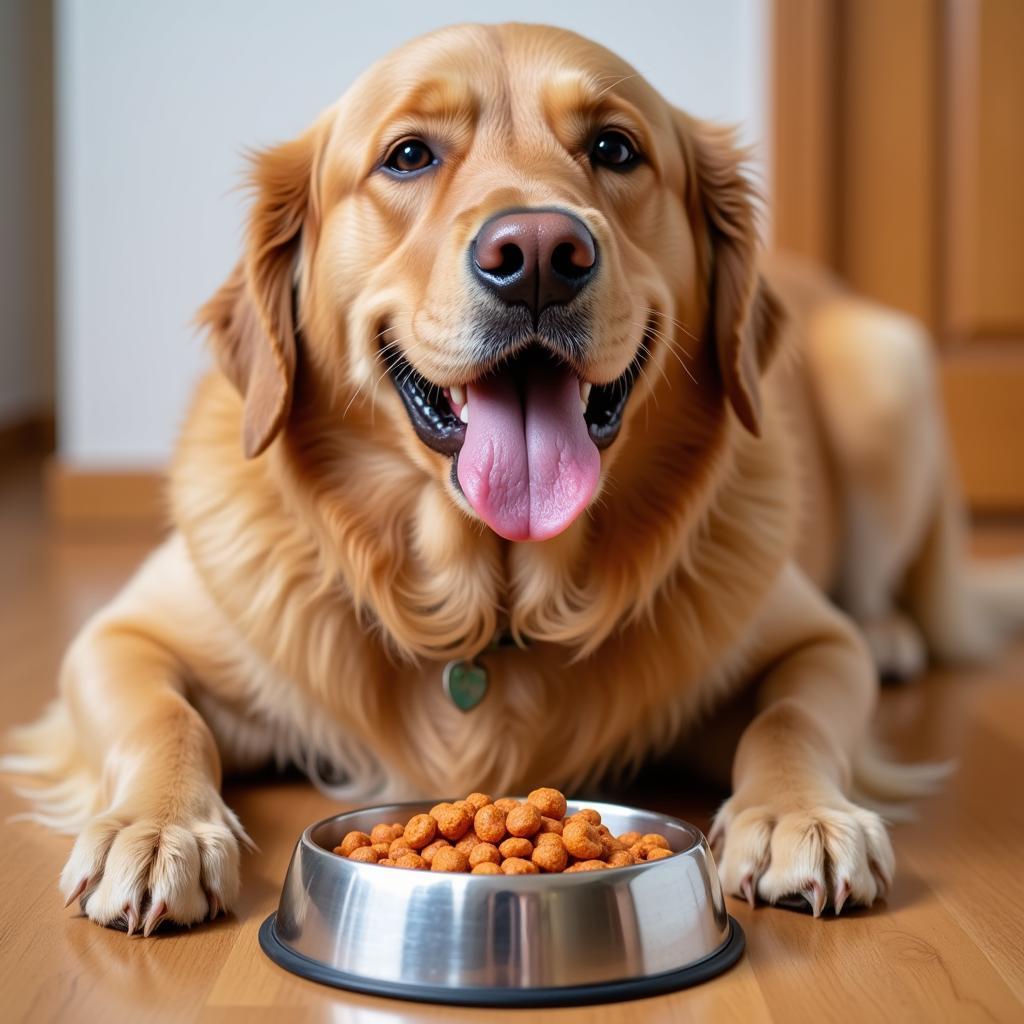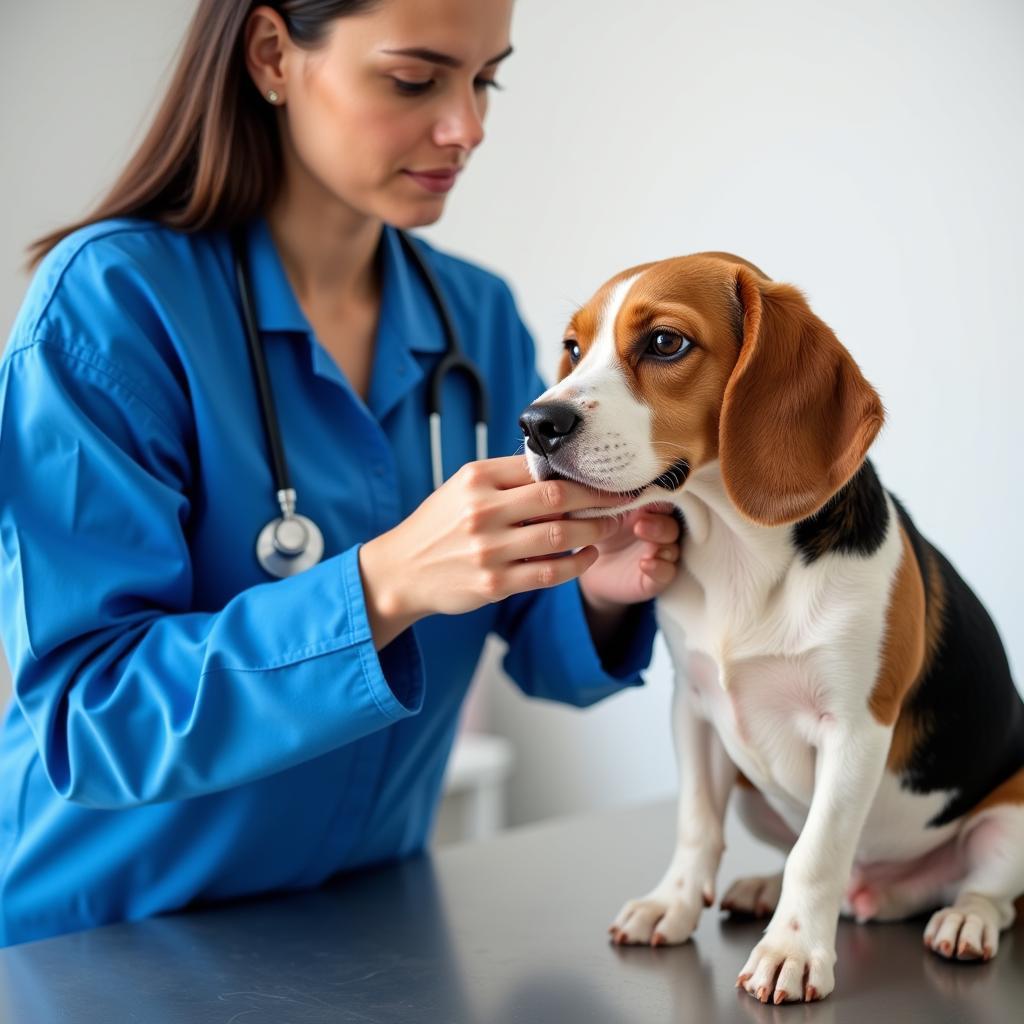Choosing the right food for your dog can feel overwhelming, especially with so many options on the market. Two popular choices are salmon and lamb-based dog foods. But which one comes out on top? This article dives deep into the salmon vs. lamb dog food debate, helping you make the best decision for your furry companion.
Nutritional Benefits: Salmon vs. Lamb
Both salmon and lamb offer a range of nutrients essential for your dog’s health. Let’s break down their nutritional profiles:
Salmon: The Omega-3 Powerhouse
 Dog enjoying a bowl of salmon dog food
Dog enjoying a bowl of salmon dog food
Salmon is a rich source of:
- Omega-3 fatty acids: These healthy fats are crucial for brain development, joint health, and a shiny coat.
- Protein: Essential for muscle growth and repair.
- Vitamins and Minerals: Salmon is packed with vitamins like B12 and D, along with minerals like selenium and potassium.
Lamb: A Highly Digestible Protein Source
 Ingredients for homemade lamb dog food
Ingredients for homemade lamb dog food
Lamb provides your dog with:
- High-quality protein: Easily digestible and great for sensitive stomachs.
- Iron and Zinc: Essential for oxygen transport and a healthy immune system.
- B Vitamins: Important for energy metabolism and overall well-being.
Which Dogs Benefit Most From Salmon?
- Dogs with allergies: Salmon is often a good choice for dogs allergic to more common protein sources like chicken or beef.
- Senior dogs: The Omega-3s in salmon can help with joint health and cognitive function in older pups.
- Dogs with skin and coat issues: Omega-3s contribute to a healthy coat and can alleviate certain skin conditions.
Which Dogs Benefit Most From Lamb?
- Picky eaters: Many dogs find the taste of lamb more appealing.
- Puppies: Lamb is a highly digestible protein source that’s gentle on developing stomachs.
- Dogs with food sensitivities: Lamb is less likely to trigger allergies than other protein sources.
Potential Downsides to Consider
While both salmon and lamb offer nutritional benefits, there are a few potential drawbacks to keep in mind:
- Mercury contamination (salmon): Opt for wild-caught salmon whenever possible to minimize mercury exposure.
- Fat content (salmon): While healthy fats are beneficial, too much salmon can lead to weight gain.
- Cost (lamb): Lamb-based dog food tends to be more expensive than other protein sources.
Making the Choice: Factors to Consider
 Veterinarian examining a dog's skin and fur
Veterinarian examining a dog's skin and fur
The best choice between salmon and lamb dog food depends on your individual dog’s needs and preferences. Here are some key factors to consider:
- Allergies and Sensitivities: If your dog has known allergies, choose a protein source they haven’t been exposed to before.
- Life Stage: Puppies, adult dogs, and senior dogs have different nutritional requirements.
- Activity Level: Active dogs may benefit from the higher calorie content of salmon-based foods.
- Budget: Lamb-based dog food can be more expensive than salmon-based options.
“Always consult with your veterinarian,” advises Dr. Emily Carter, a certified veterinary nutritionist. “They can assess your dog’s specific needs and recommend the best diet for optimal health.”
Salmon vs. Lamb Dog Food: The Bottom Line
Ultimately, the best dog food is one that provides complete and balanced nutrition for your furry friend. Both salmon and lamb offer unique benefits and can be excellent choices for dogs. By considering your dog’s individual needs and consulting with your vet, you can choose the protein source that helps them thrive.
FAQ
1. Can I feed my dog salmon and lamb together?
Yes, you can rotate between salmon and lamb-based dog foods to provide variety in their diet. Just be sure to transition gradually to avoid digestive upset.
2. Is raw salmon safe for dogs?
Raw salmon can contain parasites that are harmful to dogs. It’s best to feed cooked salmon to your furry friend.
3. What are some good alternatives to salmon and lamb dog food?
Other novel protein sources for dogs with allergies include venison, duck, and kangaroo. You can also find high-quality chicken and beef-based dog foods if your dog doesn’t have sensitivities.
4. How can I tell if my dog is allergic to their food?
Common signs of food allergies in dogs include itchy skin, ear infections, gastrointestinal upset, and hair loss.
5. Should I switch my dog’s food if they seem bored with it?
Dogs can get bored with the same food every day. You can try adding toppers like cooked meat, vegetables, or even a little bit of dog sausage food to their kibble.
For more information on choosing the right food for your furry friend, check out our article on lamb vs salmon dog food.
Need help deciding if Purina Pro Plan UR dog food is right for your dog? We’ve got you covered!
Wondering is lamb dog food better than chicken? Explore our in-depth comparison to find the perfect match for your pup.
We are here to support you and your pet’s health journey. If you need assistance, please contact us at Phone Number: 02437655121, Email: [email protected], or visit our address at 3PGH+8R9, ĐT70A, thôn Trung, Bắc Từ Liêm, Hà Nội, Việt Nam. Our customer care team is available 24/7.